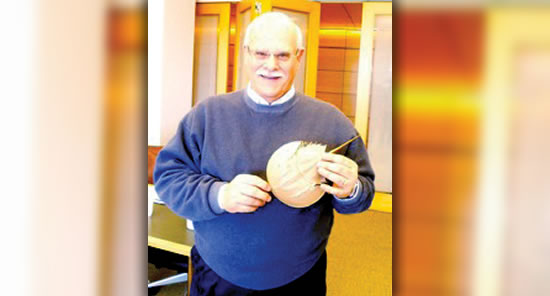MOLLOY COLLEGE'S SATURDAY SCIENCE
ORGANIZED BY DR. JOHN TANACREDI
What Came First? The Dinosaur or the Egg?
By Margaux Montagner

Dr. John Tanacredi, Professor, Molloy College
On a recent Saturday, teenagers gathered at the Explorer’s Club in the Upper East Side for the 3rd talk in the “Saturday Science for Students” series. Sponsored by Molloy’s Center for Environmental Research and its Department of Biology, Chemistry and Earth Studies, these sessions offer a chance for high-schoolers to hear scientists from different fields present their career paths, interests and research. This particular event, titled “My Career in Developmental Biology; What Came First: The Dinosaur or the Egg?”, featured Dr. Anthony J. Tolvo, professor of Biology at Molloy College.
In a practical, no-nonsense way, Dr. Tolvo presented his research to the audience, starting appropriately with the beginning of all things: the cell … stem cells, to be precise, and their specific behaviors. On a wall of the stately Clark Room, Dr. Tolvo displayed a photo of a chicken embryo, pointing out its particular structure, and drawing attention to the fact that as vertebrates, birds have a similar structure to human beings, an interesting point to consider a week prior to Thanksgiving. He then moved on from that comparison to point out evidence showing birds evolved from dinosaurs, such as the three digits on their forelimbs, the hollowness of their bones, and, evocatively, feather impressions on fossils.
Having thus set up his presentation, Dr. Tolvo briefly mentioned his professional background.
After beginning his career as a biochemical endocrinologist, he eventually switched to developmental biology — a logical evolution, as both paths are based on signal transduction. Signal transduction, or cell signaling, is the transmission of molecular signals to the inside of a cell. For example, a hormone combined with a receptor can initiate a series of biochemical steps, triggering a response from a cell. Different types of chemical messengers can activate different types of transduction, and enhance or repress another.
To illustrate this idea, Dr. Tolvo used the example of limbs in early development, when they are little more than “flaps of skin”. For humans, they have to differentiate according to a set pattern, to produce more or less identical sets of arms or legs. This process is tightly controlled by genes switching on and off at very precise times — signal transduction in action.
Going back to the chicken embryo, Dr. Tolvo pointed out that early in their development, all vertebrates tend to look quite similar. Later differentiation between species depends on gene-controlled patterns, which determinate everything “even the coiling of the large intestine”. But while these genes mold each mammal in their own specific ways, oddities can occur naturally to demonstrate some hidden, ancestral genes expressing themselves. Dr. Tolvo mentioned the presence of pelvic appendages on a dolphin, or polydactyl horses — horses born with additional hooves, a prehistoric trait for the species.
At that moment, Dr. Tolvo revealed his most recent area of research, retro-engineering. He then asked: Considering our present-day knowledge, is there a way to play around with the genes that control patterning, and, for instance, give a bird a longer tail? Or to make primitive teeth appear on a chicken? Can we take the genes of a bird and tweak them […] so that they start to express older traits? The follow-up question, Dr. Tolvo joked, should be: Why would anyone want to get such genes to be expressed, or why would anyone want to get chased down the street by a chicken with teeth and claws?
This brought the presentation back to its title, and to dinosaurs. While resurrecting dinosaurs from their ancient DNA is impossible, as DNA get too fragmented over time, they could be retro-engineered from birds instead using technology. The goal of this process would not be to replicate the famous Steven Spielberg movie and build a theme park, however, “because we know what happens when you do that”, Dr. Tolvo facetiously added. Instead, it could provide a way of observing molecular mechanisms in order to determine how to use or modify them, and apply that expertise to clinical challenges, possibly arresting progressive diseases.
Ending his presentation, Dr. Tolvo asked the audience to contemplate a striking fact: Considering what modern birds evolved from, they are, in essence, “the only dinosaurs left”. Something to ponder during one’s next encounter with a pigeon. #
